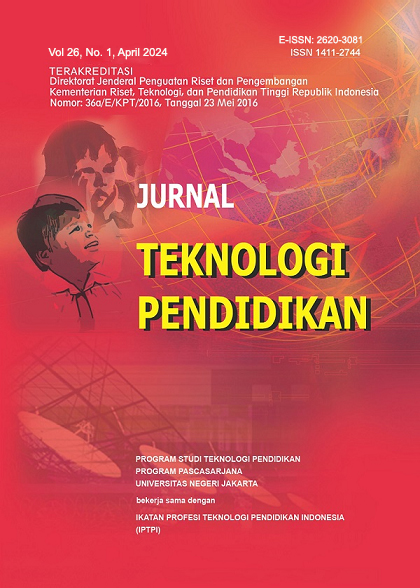The Effect of Seamless Learning on Learning Outcomes
DOI:
https://doi.org/10.21009/jtp.v26i1.48989Keywords:
Seamless Learning, Learning Management System, Problem Solving, Learning Outcomes, Basic PhysicsAbstract
This research investigates the effect of seamless learning on learning outcomes (problem-solving and procedural) in Basic Physics courses. LMS-assisted seamless learning strategy with zoom-assisted seamless learning strategy through a quasi-experimental research design with 2x2 factorial. This research involved 73 students at Akba Technology University Makassar as research subjects. They are students in the Basic Physics course in the first semester of the 2022/2023 academic year. Students are divided into two groups. The experimental group consisted of 37 students who carried out the learning process using a seamless learning strategy assisted by LMS, while the control group consisted of 36 students who carried out the learning process using a seamless learning strategy assisted by Zoom. This research uses test instruments in the form of multiple-choice and essays. Data analysis used Multivariate Analysis of Variance (MANOVA). The research results show that, firstly, there is a significant difference in problem-solving learning outcomes between students taught using seamless learning assisted by LMS and seamless learning assisted by Zoom. Second, there is a significant difference in procedural learning outcomes between students taught using seamless learning assisted by LMS and seamless learning assisted by Zoom.
References
Amhag, L. (2017). Mobile-Assisted Seamless Learning Activities in Higher Distance Education. International Journal of Higher Education, 6(3), 70. https://doi.org/10.5430/ijhe.v6n3p70
Ausi, M. B. A., & Abdillah, M. L. (2020). The use of seamless learning strategy on student vocabullary mastery. Jurnal Pendidikan, 29(3), 197–202. https://doi.org/10.32585/jp.v29i3.983
Baharun, H., Muali, C., Bali, M. M. E. I., Rozi, F., Rodiah, L. N., Munawaroh, Z., & Aminah, S. (2021). Learning Strategies for Mobile-Assisted Seamless Learning: A Students’ Initial Perceptions. 557–560. https://doi.org/10.2991/assehr.k.210312.089
Cao, L. (2023). Benefits and challenges of using LMS in blended learning: Views from EFL teachers and students at a Vietnamese public university. International Journal of TESOL & Education, 3, 78–100. https://doi.org/10.54855/ijte.23335
Cross, S., Sharples, M., Healing, G., & Ellis, J. (2019). International Review of Research in Open and Distributed Learning Distance Learners’ Use of Handheld Technologies: Mobile Learning Activity, Changing Study Habits, and the “Place” of Anywhere Learning. International Review of Research in Open and Distance Learning, 20(2), 223–241.
Degeng, N. S. (2013). Ilmu pembelajaran klasifikasi variabel untuk pengembangan teori dan penelitian. Aras Media.
Durak, G., & Çankaya, S. (2018). Seamless Learning: A Scoping Systematic Review Study. Journal of Education and E-Learning Research, 5(4), 225–234. https://doi.org/10.20448/journal.509.2018.54.225.234
Gopinathan, S., Kaur, A., Veeraya, S., & Raman, M. (2022). The Role of Digital Collaboration in Student Engagement towards Enhancing Student Participation during COVID-19. Sustainability, 14, 6844. https://doi.org/10.3390/su14116844
Greenstein, M. N. (2012). Creative judging: Ethics issues in problem-solving courts. Judges Journal, 51(2).
Hamid, A., Setyosari, P., Ulfa, S., & Kuswandi, D. (2019). The Implementation of Mobile Seamless Learning Strategy in Mastering Students’ Concepts for Elementary School. Journal for the Education of Gifted Young Scientists, 7, 967–982. https://doi.org/10.17478/jegys.622416
Mutmainnah, A., Putra, Z., & Syahrilfuddin, S. (2021). The Relationship Between Fifth Grade Students’ Number Sense and Mathematical Problem Solving. PrimaryEdu - Journal of Primary Education, 5. https://doi.org/10.22460/pej.v5i1.1722
Purba, R. A., Munthe, R. G., & Ginting, K. (2022). Learning Model with LMS as an Innovation to Facilitate the Implementation of Learning from Home. JPI (Jurnal Pendidikan Indonesia), 11(2), 293–301. https://doi.org/10.23887/jpiundiksha.v11i2.38811
Rittle-Johnson, B., & Star, J. R. (2009). Compared With What? The Effects of Different Comparisons on Conceptual Knowledge and Procedural Flexibility for Equation Solving. Journal of Educational Psychology, 101(3), 529–544. https://doi.org/10.1037/a0014224
Schunk, D. H., & Greene, J. A. (2017). Handbook of Self-Regulation of Learning and Performance, Second Edition. Handbook of Self-Regulation of Learning and Performance, Second Edition, 1–514. https://doi.org/10.4324/9781315697048
Setyosari, P. (2016). Metode Penelitian Pendidikan & Pengembangan. Prenada Media.
Slavin, R. E. (2015). Cooperative Learning: Teori, Riset dan Praktik. Nusa Media.
Virtanen, P., Niemi, H., & Nevgi, A. (2017). Active Learning and Self-Regulation Enhance Student Teachers’ Professional Competences. Australian Journal of Teacher Education, 42(12). https://doi.org/10.14221/ajte.2017v42n12.1
Wilson, L. O. (2016). Anderson and Krathwohl Bloom’s Taxonomy Revised Understanding the New Version of Bloom’s Taxonomy. The Second Principle, 1–8.
Wong, L. H., Milrad, M., & Specht, M. (2015). Seamless learning in the age of mobile connectivity. Seamless Learning in the Age of Mobile Connectivity, 1–500. https://doi.org/10.1007/978-981-287-113-8
Yetik, E., Ozdamar, N., & Bozkurt, A. (2019). Seamless Learning Design Criteria in the Context of Open and Distance Learning. 106–127. https://doi.org/10.4018/978-1-5225-9779-7.ch006
Zainal, A. G., Prakoso, G. H., Frasetya, V., Faizal, A. R., Fardiyan, R., & Sanjaya, F. J. (2022). Zoom Utilization as an Online Learning Media during the COVID-19 Pandemic. Journal of Innovation in Educational and Cultural Research, 3(2), 242–247. https://doi.org/10.46843/jiecr.v3i2.99
Downloads
Published
How to Cite
Issue
Section
License
Copyright (c) 2024 Listia Utami, Punaji Setyosari, Dedi Kuswandi, Henry Praherdhiono

This work is licensed under a Creative Commons Attribution-ShareAlike 4.0 International License.
Jurnal Teknologi Pendidikan is an Open Access Journal. The authors who publish the manuscript in Jurnal Teknologi Pendidikan agree to the following terms.
Attribution-ShareAlike 4.0 International (CC BY-SA 4.0)
-
Attribution — You must give appropriate credit, provide a link to the license, and indicate if changes were made. You may do so in any reasonable manner, but not in any way that suggests the licensor endorses you or your use.
-
ShareAlike — If you remix, transform, or build upon the material, you must distribute your contributions under the same license as the original.
- No additional restrictions — You may not apply legal terms or technological measures that legally restrict others from doing anything the license permits.
Notices:
- You do not have to comply with the license for elements of the material in the public domain or where your use is permitted by an applicable exception or limitation.
- No warranties are given. The license may not give you all of the permissions necessary for your intended use. For example, other rights such as publicity, privacy, or moral rights may limit how you use the material.








